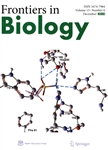Evaluation of protein Z plasma level in beta-thalassemia major patients in Ahvaz city in Iran
在 beta-thalassemia 的蛋白质 Z 血浆水平的评估在伊朗的 Ahvaz 城市里的主要病人作者机构:Department of Laboratory Sciences Hyperlipidemia Research Center Diabetes Research Center Jundishapur University of MedicalSciences Ahvaz Iran Shefa Neuroscience Research Center KhatamAlanbia Hospital Tehran Iran Blood Transfusion Research Center High Institute for Research and Education in Transfusion Medicine Tehran Iran Golestan Hospital Clinical Research Development Unit Ahvaz Jundishapur University of Medical Sciences Ahvaz Iran
出 版 物:《Frontiers in Biology》 (生物学前沿(英文版))
年 卷 期:2017年第12卷第6期
页 面:442-447页
核心收录:
学科分类:0710[理学-生物学] 07[理学] 09[农学]
基 金:Ahvaz Jundishapur University of Medical Sciences
主 题:major beta-thalassemia protein Z thrombosis immunoassay anti-coagulation factor
摘 要:Objectives Thrombotic episodes occurred frequently in beta-thalassemia major (BTM) patients, leading to hypercoagulability of plasma. Protein Z (PZ) is a vitamin-K-dependent anti-coagulation factor that plays a role in the human homeostatic process. The objective of the current study is to investigate the distribution pattern of PZ plasma concentrations between BTM patients and the normal population in Ahvaz city, the center of Khuzestan province, southwest of *** and Methods Forty confirmed BTM patients and 40 healthy volunteers were evaluated for complete blood count (CBC) indices and PZ plasma levels. CBC samples were measured using an automated cell counter, and PZ was assayed with an immunoassay method. Statistical analysis was conducted using SPSS software. The ROC curve and binary logistic regression estimated the sensitivity, specificity, and Odd’s ratio for PZ *** The mean±SD of the PZ plasma level in normal individuals was 1.68±0.63 μg/mL, and in BTM patients, it was 1.10±0.52 μg/mL. This shows a significant reduction of PZ in BTM patients statistically (CI = 0.99; p0.001). Further, the mean±SD of the PZ plasma levels in BTM patients who received washed red blood cells was not significantly different from that of patients undergoing packed red blood cell therapy (CI = 0.95; p = 0.320). The area under the curve (AUC) for PZ was 0.759 (p = 0.00). The cut-off value = 1.4 μg/mL of the PZ plasma level had at least 70% sensitivity and specificity in BTM *** Several epidemiologic studies have shown thromboembolism episodes in BTM patients. In the current study, PZ was reduced significantly in *** We noticed that BTMs have lower plasma PZ concentration might be predisposed to BTM.



